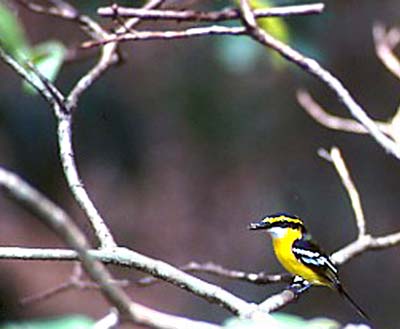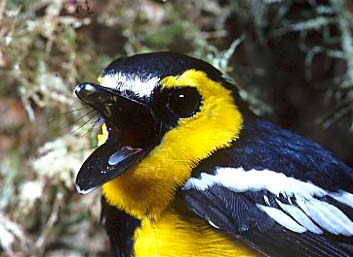 The
Machaerirhynchidae is a small family of two boatbills in the genus Machaerirhynchus.
They are limited to Australasia. The most familiar is the Yellow-breasted
Boatbill (left), photographed near its nest by Cliff & Dawn
Frith, of the lowlands of northeast Australia, New Guinea, and some
west Papuan islands. It is a flycatcher-like bird in humid jungles, named
for its broad bill. For a long time the Boatbills were considered to be
among the Monarch-Flycatchers [Monarchidae] or, in other words, "just another
flycatcher." Among its alternate names in Australia were "Boat-billed Flycatcher,"
"Yellow-breasted Flatbill," and "Yellow-breasted Flycatcher" (Frith 1979). The
Machaerirhynchidae is a small family of two boatbills in the genus Machaerirhynchus.
They are limited to Australasia. The most familiar is the Yellow-breasted
Boatbill (left), photographed near its nest by Cliff & Dawn
Frith, of the lowlands of northeast Australia, New Guinea, and some
west Papuan islands. It is a flycatcher-like bird in humid jungles, named
for its broad bill. For a long time the Boatbills were considered to be
among the Monarch-Flycatchers [Monarchidae] or, in other words, "just another
flycatcher." Among its alternate names in Australia were "Boat-billed Flycatcher,"
"Yellow-breasted Flatbill," and "Yellow-breasted Flycatcher" (Frith 1979).
Biochemical evidence has shown that boatbills are not closely related to any flycatcher family (see below) but they behave similarly. They move singly or in pairs through the lower and middle stories of rainforest, often calling, and capturing insects. While they will 'sally forth' to snap up insects at the apex of short flights, much of their insect diet is plucked from the foliage rather than by flycatching. or by hovering in front of leaves. Boatbills perch horizontally (unlike typically upright flycatchers in other families) and, when excited, cocks its tail up like a wren. All these behavior are unlike "typical" flycatchers (Frith 1979, Simpson & Day 1996, Morcombe 2000). |
 The
only other species in this newly elevated family is Black-breasted Boatbill
(right) of the mountains of New Guinea. This wonderful shot by Cliff
& Dawn Frith is of a hand-held bird netted in the field. Black-breasted
Boatbill is the highland representative, occurring mostly above 3000' elevation.
It differs from Yellow-breast Boatbill in a variety of ways, including
a different facial pattern (yellow of lower face wraps up behind the eye
to supercilium), a yellow (not white) throat, and it has a black breast
patch. The
only other species in this newly elevated family is Black-breasted Boatbill
(right) of the mountains of New Guinea. This wonderful shot by Cliff
& Dawn Frith is of a hand-held bird netted in the field. Black-breasted
Boatbill is the highland representative, occurring mostly above 3000' elevation.
It differs from Yellow-breast Boatbill in a variety of ways, including
a different facial pattern (yellow of lower face wraps up behind the eye
to supercilium), a yellow (not white) throat, and it has a black breast
patch.
Although I have seen Yellow-breasted Boatbill several times, I have much more vivid memories of Black-breasted Boatbill. In Oct 1983, my friends and I found an active nest of Black-breasted Boatbill on Mt. Kaindi in Papua New Guinea. On 24 July 1994, I got to spend a morning birding with Seth, our local sharp-eyed guide, in the Arfak Mountains of the Vogelkop, Irian Jaya, eastern New Guinea. Among the day's highlights were wonderful experiences with Vogelkop Bowerbird, observing a Spotted Jewel-thrush, and spotting a fycatching Black-breasted Boatbill. This was the only Black-breasted Boatbill seen during three weeks in Irian Jaya; the species is widespread in the mountains but numbers are thinly spread (Beehler et al. 1986, Coasts 1990). Sibley & Ahlquist (1990) and Sibley & Monroe (1990 apparently did not have DNA samples of either boatbill; they placed them next to Magpie-Lark Grallina cyanoleuca with the monarch flycatchers. More recent work, especially the sequencing of nuclear genes and the use of a broader range of analytical tools, has not supported this arrangement. In published work, Barker et al. (2004) reassigned a wide variety of genera from Australasia into new and sometimes unexpected patters. Keith Barker, the lead author of that paper, tells me (pers. comm.) that unpublished data support other taxonomic allocations published by Dickinson (2003). Among those decisions is one that elevates the Boatbills to family status as the Machaerirhynchidae. This decision is apparently based on unpublished DNA evidence obtained by Joel Cracraft, who made the family level decisions in Dickinson (2003). We should look for the publication of these data in the future. It thus appears that the boatbills arose separately from all other flycatchers and evolved flycatching bills through convergent evolution. Given that some of their behaviors are unlike other flycatchers, it is rather easy for me to adjust to this new, and elevated, status. Both boatbills are striking and interesting jungle birds, and it is very interesting to learn that they evolved on a different ancestral lineage than the rest of the flycatchers in Australasia. |
|
Photos: Many thanks to Cliff & Dawn Frith, well-known wildlife photographers in Australia and New Guinea, who graciously provided photos of both species. Without their help, I had nothing to illustrate this family. The Yellow-breasted Boatbill Machaerirhynchus flaviventer was photographed on the Cape York Peninsula, Queensland, Australia. The Black-breasted Boatbill M. nigripectus was netted and photographed in the mountains of Papua New Guinea. All photos © Cliff & Dawn Frith and used with permission; all rights reserved. Many other photos by Cliff & Dawn Frith are in Coates (1990), and are featured on a website for Rosegums lodge on the Cape York Peninsula, which also features some of their photography books. Bibliographic notes There is no "family book" covering the Machaerirhynchidae, although good photographs and information about Australian and New Guinea species are found in Frith (1979) and Coates (1990), respectively. Literature cited: Barker, F.K., A. Cibois, P. Schikler, J. Feinstein, and J. Cracraft. 2004. Phylogeny and diversification of the largest avian radiation. Proc. Nat. Acad. Sci. 101: 11040-11045. |